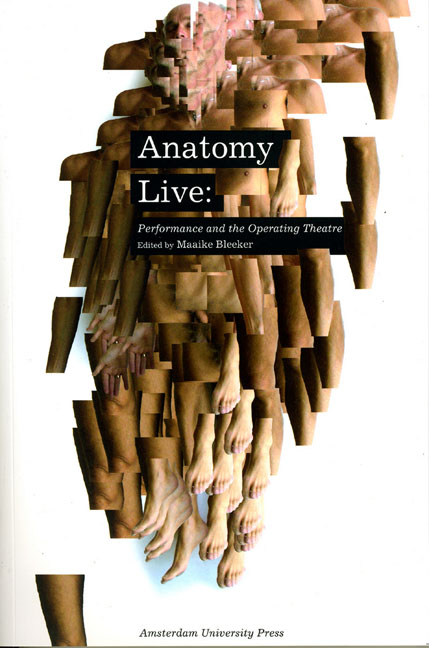Book contents
- Frontmatter
- Contents
- Acknowledgements
- Prologue - Men with Glass Bodies
- Introduction
- Performance Documentation 1: Holoman; Digital Cadaver
- Digital Cadavers and Virtual Dissection
- ‘Who Were You?’: The Visible and the Visceral
- Performance Documentation 2: Excavations: Fresh but Rotten
- The Anatomy Lesson of Professor Moxham
- ‘Be not Faithless But Believing’: Illusion and Doubt in the Anatomy Theatre
- Performance Documentation 3: De Anatomische Les
- Of Dissection and Technologies of Culture in Actor Training Programs – an Example from 1960s West Germany
- Ocular Anatomy, Chiasm, and Theatre Architecture as a Material Phenomenology in Early Modern Europe
- Performance Documentation 4: Camillo – Memo 4.0: The Cabinet of Memories – A Tear Donnor Session
- Martin, Massumi, and the Matrix
- Performance Documentation 5: Sensing Presence no 1: Performing a Hyperlink System
- ‘Where Are You Now?’: Locating the Body in Contemporary Performance
- Performance Documentation 6: Under My Skin
- Anatomies of Live Art
- Performance Documentation 7: Crash
- Restaging the Monstrous
- Delirium of the Flesh: ‘All the Dead Voices’ in the Space of the Now
- Performance Documentation 8: Körper
- Operating Theatres: Body-bits and a Post-apartheid Aesthetics
- Index
Performance Documentation 2: Excavations: Fresh but Rotten
Published online by Cambridge University Press: 10 February 2021
- Frontmatter
- Contents
- Acknowledgements
- Prologue - Men with Glass Bodies
- Introduction
- Performance Documentation 1: Holoman; Digital Cadaver
- Digital Cadavers and Virtual Dissection
- ‘Who Were You?’: The Visible and the Visceral
- Performance Documentation 2: Excavations: Fresh but Rotten
- The Anatomy Lesson of Professor Moxham
- ‘Be not Faithless But Believing’: Illusion and Doubt in the Anatomy Theatre
- Performance Documentation 3: De Anatomische Les
- Of Dissection and Technologies of Culture in Actor Training Programs – an Example from 1960s West Germany
- Ocular Anatomy, Chiasm, and Theatre Architecture as a Material Phenomenology in Early Modern Europe
- Performance Documentation 4: Camillo – Memo 4.0: The Cabinet of Memories – A Tear Donnor Session
- Martin, Massumi, and the Matrix
- Performance Documentation 5: Sensing Presence no 1: Performing a Hyperlink System
- ‘Where Are You Now?’: Locating the Body in Contemporary Performance
- Performance Documentation 6: Under My Skin
- Anatomies of Live Art
- Performance Documentation 7: Crash
- Restaging the Monstrous
- Delirium of the Flesh: ‘All the Dead Voices’ in the Space of the Now
- Performance Documentation 8: Körper
- Operating Theatres: Body-bits and a Post-apartheid Aesthetics
- Index
Summary
The creation of the perfect imperfect
A physician told Marijs Boulogne how he fell into a depression for years after having suffered the loss of his newborn baby. ‘How can it be that he, as a physician, does not have an answer to that?’ Boulogne wondered. ‘How come he has so much trouble finding ways to deal with this event?’ His account made her notice the lack of narratives around this topic. It made her decide to create a story about it herself.
She began by asking herself: ‘What would I do if it happened to me? In what way could I prepare myself for such an event? How would I be able to find consolation?’ In reaction to these questions, she started to make a dress that, in case it DID happen to her, she would be able to put on her own baby. She spent three months working on the dress, driven by the colours she was using for the embroidery. By the time she had the finished dress, it occurred to her that this was only the beginning. She decided to create the baby as well.
The preparation of this project took a couple of years. Boulogne experimented with imitating little pieces of skin and organs. The process was slow and very expensive: she soon ran out of money and material. But then she accidentally inherited piles of embroidery thread and crewel from a woman at whose deathbed she sat for months and from her grandmother, who was losing her sight. The thousand colours of this new material encouraged her decision to really start with her project, which she named Excavations .
Boulogne made an enormous effort to create all the baby's organs in full anatomical detail, and to correctly shape its little bones out of salt dough. For more than a year she studied anatomical manuals and read accounts of surgeons to learn about the organs she was imitating, and to become acquainted with the vocabulary of the medical discourse. Travelling frequently, she kept working on the baby. She made the placenta in Copenhagen, the kidneys in Italy, and continued her work on the intestines in Sydney. As the features of the baby began to grow, she started to get inquiring looks when screening her baggage at customs.
- Type
- Chapter
- Information
- Anatomy LivePerformance and the Operating Theatre, pp. 67 - 74Publisher: Amsterdam University PressPrint publication year: 2008



